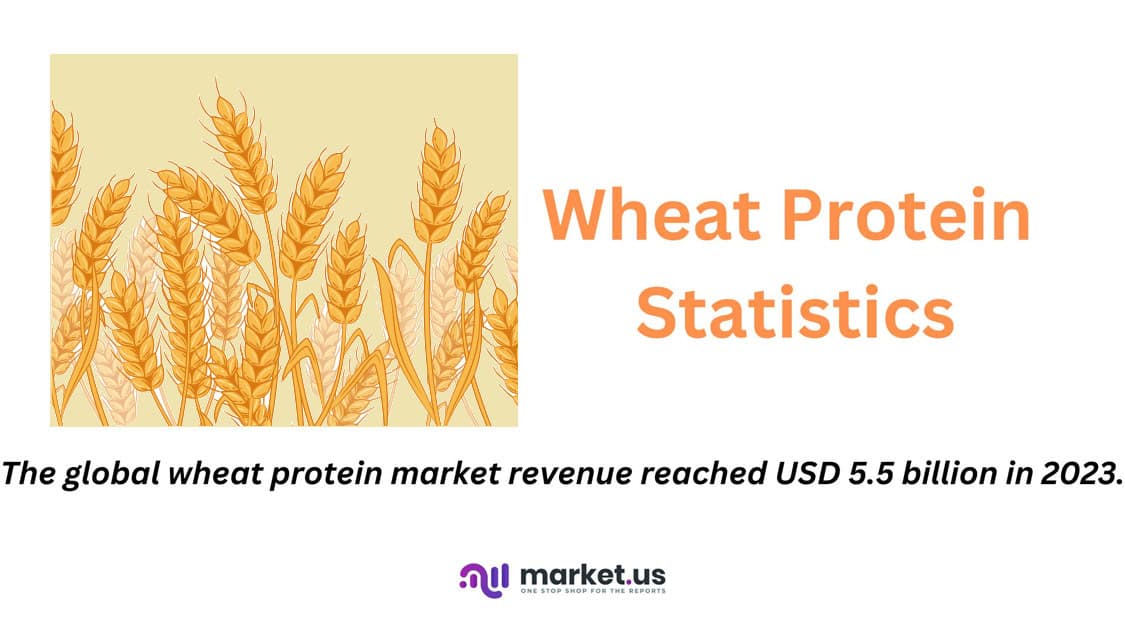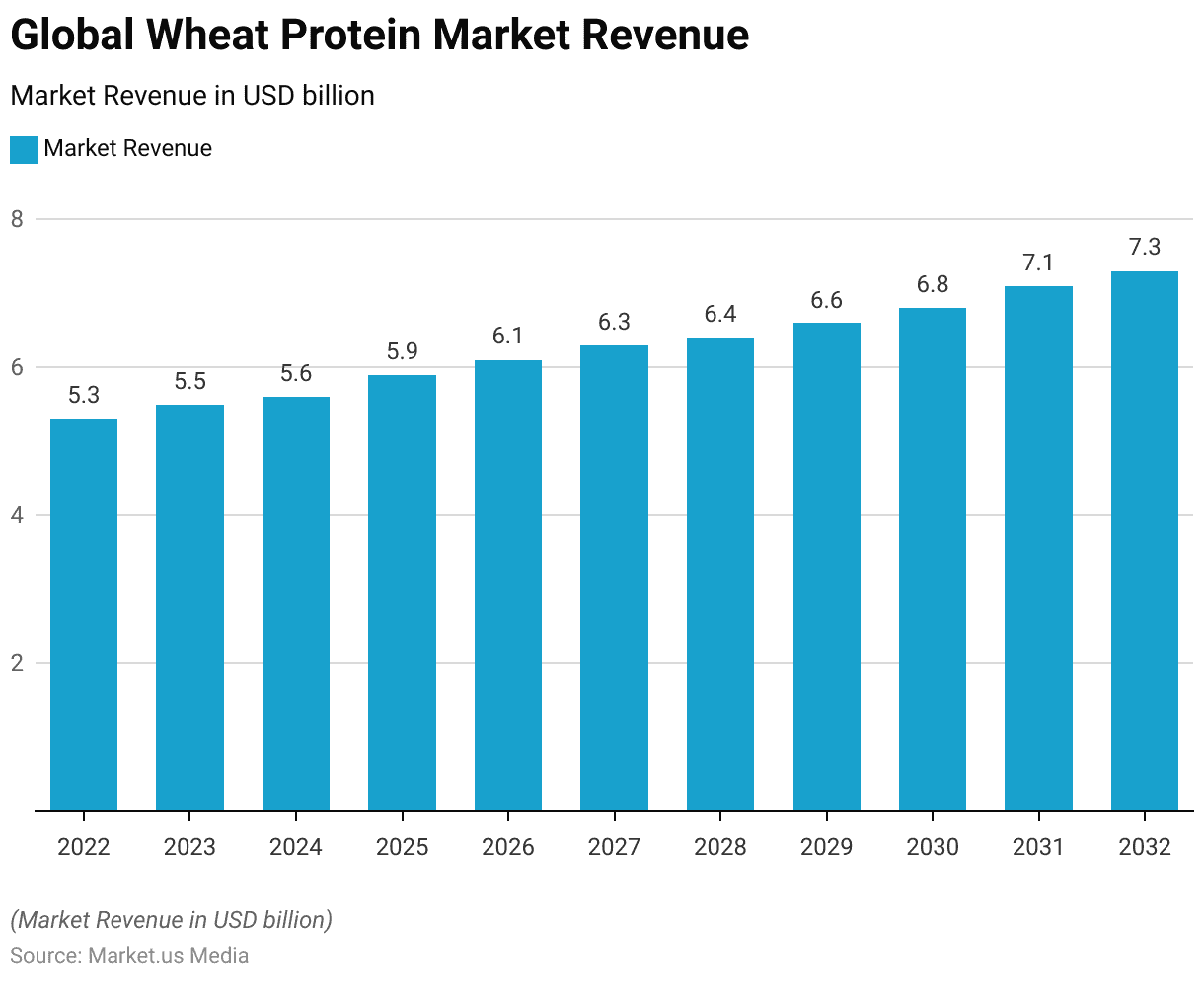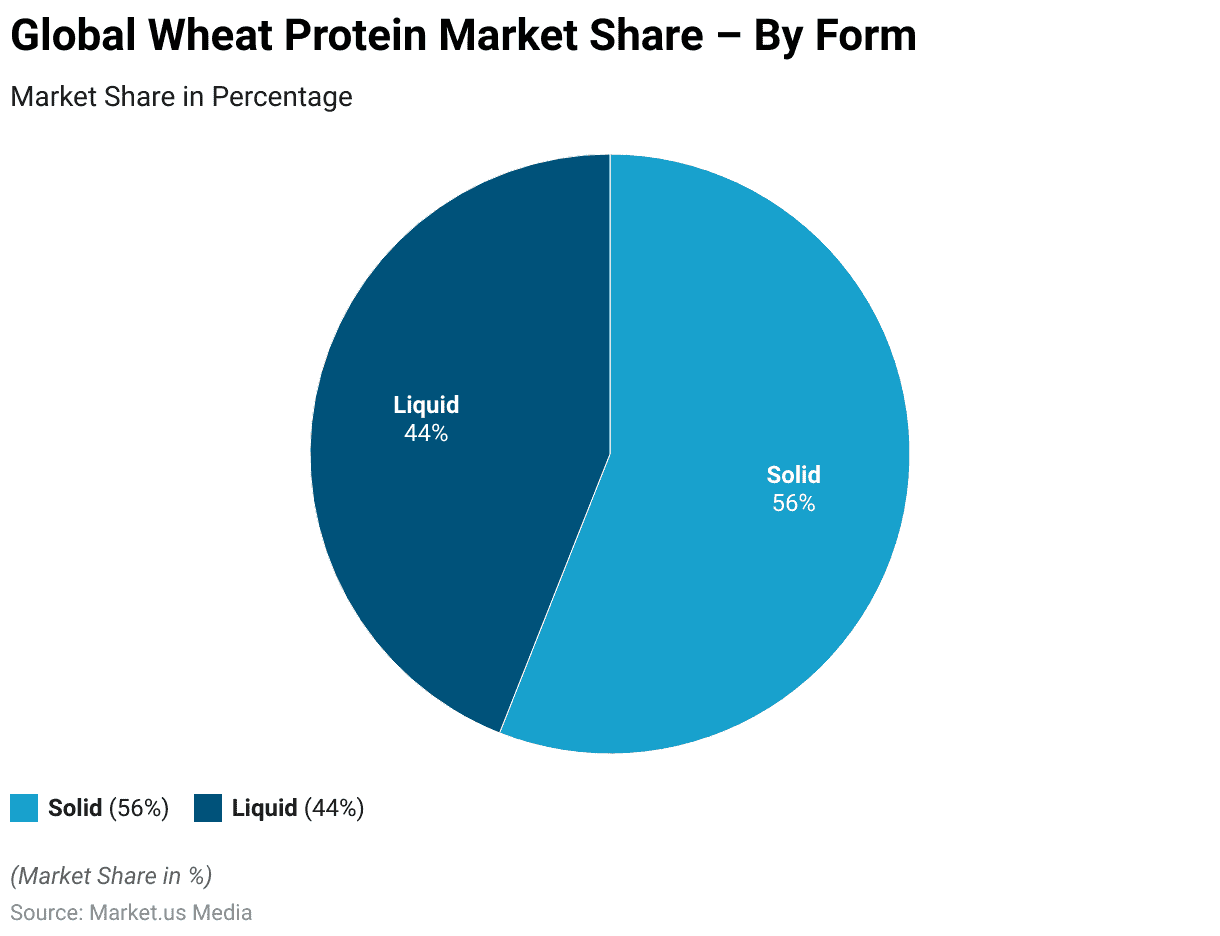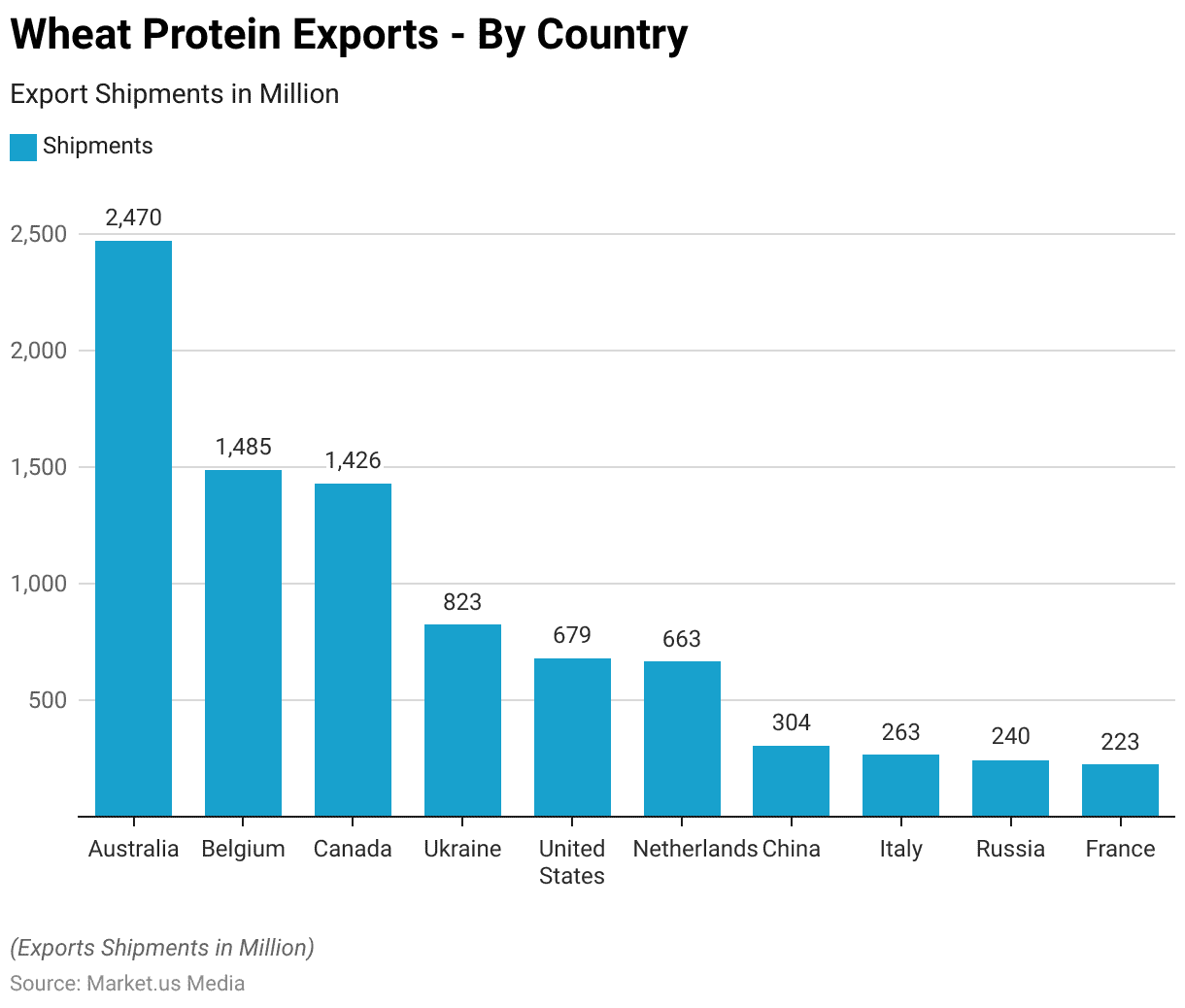Table of Contents
- Introduction
- Editor’s Choice
- Global Wheat Protein Market Overview
- Nutritional Components of Wheat Gluten (Per 100g)
- Top Wheat Protein Exporting Nations Statistics
- Top Wheat Protein Importing Nations Statistics
- Parentage of Bread Wheat Genotypes
- Latest Innovations in Wheat Protein Extraction and Processing Statistics
- Recent Developments
- Conclusion
- FAQs
Introduction
Wheat Protein Statistics- Wheat protein, with its distinct types including wheat gluten, wheat protein isolate, textured wheat protein, and hydrolyzed wheat protein, plays a crucial role in various industries due to its unique properties.
This Wheat gluten, known for its elasticity, is indispensable in baking and as a meat substitute. Wheat protein isolate, higher in protein ingredients, is favored in dietary supplements and high-protein, low-carbohydrate foods.
Textured wheat protein is popular in vegetarian and vegan diets for its meat-like texture, while hydrolyzed wheat protein is utilized in cosmetics for its conditioning properties.
These applications span food and beverages, animal feed, personal care, and even industrial uses, underlining the versatility and significance of wheat protein in meeting dietary needs, improving product textures, and supporting sustainability efforts across different sectors.

Editor’s Choice
- The global wheat protein market revenue reached USD 5.5 billion in 2023.
- The trend culminated in 2032, when the market peaked at USD 7.3 billion, segmented into USD 3.07 billion from wheat gluten, USD 1.31 billion from wheat protein isolate, USD 1.24 billion from textured wheat protein, and USD 1.68 billion from hydrolyzed wheat protein.
- As of the latest data, solid forms of wheat protein hold a majority market share of 56%, underscoring their widespread use and preference in various applications.
- Wheat gluten, a key wheat protein variant, is rich in nutrients, especially protein, which makes up about 75-80g per 100g.
- Australia leads as the top exporter of wheat protein, boasting shipments totaling 2,470 million.
- The United States stands as the leading importer of wheat protein, with shipments reaching 4,054 million, highlighting its significant demand in the country.
- Research indicates that the UAE can enhance protein yields by 10-20% over conventional methods.

Global Wheat Protein Market Overview
Global Wheat Protein Market Size Statistics
- The global wheat protein market has exhibited a steady growth trajectory from 2022 to 2032 at a CAGR of 3.40%.
- Starting at a revenue of USD 5.3 billion in 2022, the market witnessed a slight increase to USD 5.5 billion in 2023, followed by a marginal rise to USD 5.6 billion in 2024.
- The growth pace moderately accelerates, reaching USD 5.9 billion in 2025 and continuing to climb to USD 6.1 billion in 2026.
- By 2027, the market value will rise to USD 6.3 billion, followed by a steady increment to USD 6.4 billion in 2028.
- The upward trend persists, with market revenues reaching USD 6.6 billion in 2029, USD 6.8 billion in 2030, and eventually climbing to USD 7.1 billion in 2031.
- This consistent growth will culminate in a market size of USD 7.3 billion by 2032, reflecting the increasing global demand and application of wheat protein across various industries.
(Source: Market.us)

Global Wheat Protein Market Size – By Product Statistics
- The global wheat protein market, delineated by product categories, has demonstrated a progressive increase in revenue from 2022 to 2032.
- In 2022, the market initiated with a total revenue of USD 5.3 billion, divided among its primary segments as follows: wheat gluten at USD 2.23 billion, wheat protein isolate at USD 0.95 billion, textured wheat protein at USD 0.90 billion, and hydrolyzed wheat protein at USD 1.22 billion.
- By 2023, total market revenue edged up to USD 5.5 billion, with incremental growth in each category, marking a continuous upward trend.
- This pattern persisted through the decade, reaching notable points such as a total market size of USD 5.9 billion in 2025, with wheat gluten contributing USD 2.48 billion, and further expanding to USD 6.8 billion in total revenue by 2030, by which point wheat gluten’s share had escalated to USD 2.86 billion.
- The trend culminated in 2032, when the market peaked at USD 7.3 billion, segmented into USD 3.07 billion from wheat gluten, USD 1.31 billion from wheat protein isolate, USD 1.24 billion from textured wheat protein, and USD 1.68 billion from hydrolyzed wheat protein.
- This sustained growth underscores the expanding utilization and value of wheat protein products across a variety of applications.
(Source: Market.us)

Global Wheat Protein Market Share – By Form Statistics
- In the wheat protein market, product forms are predominantly categorized into solid and liquid, each capturing a significant portion of the market.
- As of the latest data, solid forms of wheat protein hold a majority market share of 56%, underscoring their widespread use and preference in various applications.
- On the other hand, liquid forms of wheat protein account for 44% of the market.
- This distribution highlights the diverse applications and preferences within the industry, with solid wheat protein often favored for its ease of use and storage in food production and other sectors. In contrast, liquid wheat protein is valued for its versatility and functionality in different formulations.
(Source: Market.us)

Nutritional Components of Wheat Gluten (Per 100g)
- Wheat gluten, a key wheat protein variant, is rich in nutrients, especially protein, which makes up about 75-80g per 100g.
- It has low-fat levels, around 1.5-2g per 100g, and a moderate carbohydrate count of 5-14g per 100g, with some of this being dietary fiber, particularly in whole wheat products.
- Micronutrient-wise, it’s a source of essential B vitamins like niacin, thiamine, and folate, alongside minerals such as iron, magnesium, phosphorus, and zinc.
- However, its protein, though abundant, lacks lysine, making it necessary to pair with other proteins for a complete amino acid profile.
- With a calorie count of 300-370 kcal per 100g, wheat gluten is nutritionally dense and beneficial for those looking to enhance their diet with proteins and vital nutrients. Yet, it’s not suitable for individuals with gluten intolerance.
(Source: ReciPal)
Top Wheat Protein Exporting Nations Statistics
- Australia leads as the top exporter of wheat protein, boasting shipments totaling 2,470 million, followed by Belgium and Canada with 1,485 million and 1,426 million, respectively.
- Ukraine also contributes significantly to the global wheat protein market with 823 million, while the United States exports 679 million.
- The Netherlands is not far behind, exporting 663 million.
- Meanwhile, China, Italy, Russia, and France have lower, yet notable, export figures of 304 million, 263 million, 240 million, and 223 million, respectively.
- This distribution highlights the global landscape of wheat protein trade, where countries with vast agricultural resources and advanced processing capabilities dominate the export market, supporting global food supply chains and dietary needs.
(Source: Volza)

Top Wheat Protein Importing Nations Statistics
- The United States stands as the leading importer of wheat protein, with shipments reaching 4,054 million, highlighting its significant demand in the country.
- Vietnam follows as a major importer with 1,392 million, and Uganda is close behind with 1,281 million. Peru also plays a crucial role in the wheat protein import market, bringing in 1,228 million.
- India’s imports are notable as well, totaling 678 million, while Kenya imports 510 million, demonstrating the importance of wheat protein in their dietary consumption.
- Indonesia and South Korea have more modest figures, importing 278 million and 178 million, respectively.
- Ghana and the Philippines, though smaller in volume, still contribute to the global import landscape with 85 million and 68 million, indicating a widespread reliance on wheat protein across diverse nations for its nutritional benefits and applications in food production.
(Source: Volza)

Parentage of Bread Wheat Genotypes
- The variety of bread wheat genotypes reflects a broad spectrum of crossbreeding endeavors aimed at enhancing nutritional qualities, disease resistance, and overall yield.
- For example, the high zinc variant, PBW 1 Zn, is a result of complex breeding involving T.DICOCCON CI 9309/Ae.sq(409)/3/Milan/S.
- 87230 and BAV 92 to boost zinc levels. Genetic varieties like BWL 9023 and BWL 1663/1664, which come from crosses such as MILAN/AMSEL and GLUPRO/3∗PBW 568, showcase targeted improvements.
- C-derivatives and PBW-175 lines, including BWL 3498 and 3500 series, result from strategic crosses with WL 711-Ae. Ovata, aiming for advanced traits.
- C-lines like C 306 and C 273, as well as rainfed varieties such as PBW 175 and its derivatives, are bred for specific improvements like drought tolerance.
- This effort extends to PBW-621 derivatives and acknowledges the value of local strains, such as HIMACHAL LOCAL-1, in wheat’s genetic development.
- Overall, these genotypes represent concerted efforts in breeding to tailor wheat for diverse environmental conditions, dietary needs, and farming challenges, illustrating the comprehensive and nuanced approach to wheat genetic enhancement.
(Source: Statista)
Latest Innovations in Wheat Protein Extraction and Processing Statistics
Enzymatic Extraction
- Studies suggest enzymatic extraction can significantly increase protein yield while reducing energy consumption compared to traditional methods.
- The specificity of enzymes can lead to purer protein extracts with fewer processing steps.
(Source: MDPI)
Ultrasound-Assisted Extraction (UAE)
- Research indicates that the UAE can enhance protein yields by 10-20% over conventional methods.
- The reduction in extraction time and solvent use also contributes to cost savings and a lower environmental footprint.
(Source: MDPI)
Aqueous Two-Phase Systems (ATPS)
- ATPS can achieve high purity levels of wheat protein isolates, with some studies reporting up to a 90% purity rate.
- This method also allows for the recovery and reuse of solvents, improving overall sustainability.
(Source: MDPI)
Membrane Filtration Techniques
- Concentration and Purification: Membrane filtration can concentrate wheat proteins up to 5-10 times their original concentration in the extract, with a high degree of purity.
- This method is particularly effective in removing contaminants and smaller molecular weight substances.
(Source: MDPI)
High-Pressure Processing (HPP)
- HPP can lead to an increase in solubility and improvement in functional properties such as emulsification capacity and foam stability, which are crucial for food applications.
- The exact improvements can vary based on processing conditions and the wheat protein type.
(Source: MDPI)
Integrated Biorefinery Approaches
- By utilizing all components of wheat biomass, integrated biorefineries can significantly increase the economic value extracted per unit of raw material.
- While specific statistics may vary, the goal is to achieve near-zero waste, with substantial reductions in environmental impact compared to traditional processes.
(Source: MDPI)
Recent Developments
Acquisitions and Mergers:
- Acquisition of a leading wheat protein manufacturer by a major food conglomerate in September 2023, expanding their portfolio of plant-based protein offerings.
- The merger between two prominent wheat protein companies in December 2023, created a stronger presence in the market and enhanced research and development capabilities.
New Product Launches:
- Introduction of a range of wheat protein isolates and concentrates targeting the sports nutrition market in January 2024, capitalizing on the growing demand for plant-based protein supplements.
- Launch of wheat protein-based meat alternatives, including burgers, sausages, and nuggets, by several food companies in March 2024, catering to the rising trend of flexitarian and vegetarian diets.
Funding Rounds:
- Series B funding round for a wheat protein startup in February 2024, raising $20 million to scale up production capacity and expand distribution channels.
- Seed funding for a research initiative focused on wheat protein extraction and processing techniques in April 2024, securing $5 million for innovation in the field.
Partnerships and Collaborations:
- Collaboration between a wheat protein manufacturer and a food technology company in November 2023 to develop innovative plant-based food formulations with improved taste and texture.
- The partnership between a wheat protein supplier and a major bakery chain in March 2024 to incorporate wheat protein fortification in their product line, targeting health-conscious consumers.
Regulatory Developments:
- Implementation of regulations governing the labeling and marketing of wheat protein-based products by regulatory authorities in key markets, ensuring transparency and consumer safety.
- Introduction of sustainability standards for wheat protein production, encouraging companies to adopt eco-friendly practices and reduce their environmental footprint.
Investment Landscape:
- Venture capital investments in wheat protein startups totaled $50 million in 2023, with a focus on companies developing innovative technologies for protein extraction and processing.
- Strategic acquisitions and partnerships between food companies and wheat protein suppliers accounted for 40% of total investment activity in the wheat protein market, reflecting industry consolidation and vertical integration efforts.
Conclusion
Wheat Protein Statistics – Wheat protein plays a crucial role in the global food industry and the growing plant-based market, valued for its nutritional content, functional flexibility, and eco-friendliness.
The surge in demand has spurred innovations in extraction and processing techniques, such as enzymatic extraction and high-pressure processing, improving wheat protein’s efficiency, yield, and usability.
These advancements cater to the increasing interest in plant-based proteins and support environmental objectives by optimizing resource usage and minimizing waste.
With the global population on the rise, wheat protein’s importance in food security, health promotion, and sustainable development is increasingly significant.
Continuous research in this field underscores its vital contribution to meeting the nutritional and environmental challenges ahead, positioning it as a key interest for stakeholders across sectors.
FAQs
Wheat protein, primarily found in the form of gluten, is a complex of proteins, including gliadin and glutenin. It is extracted from wheat and is known for its unique viscoelastic properties, making it highly valuable in food production, especially in baking and meat alternatives.
Wheat protein is important due to its high nutritional value, providing essential amino acids, vitamins, and minerals. It’s also prized for its functional properties in food processing, contributing to the texture and structure of various products. Additionally, wheat protein supports sustainable food production practices by offering plant-based protein options.
While wheat protein is rich in many essential amino acids, it is considered incomplete because it lacks sufficient amounts of lysine. However, when combined with other protein sources that contain lysine, it can contribute to a balanced diet.
Individuals with gluten intolerance or celiac disease should avoid wheat protein due to its gluten content, as it can trigger adverse health reactions. Alternatives should be sought in such cases.
Innovations in wheat protein extraction and processing include enzymatic extraction, ultrasound-assisted extraction, aqueous two-phase systems, membrane filtration, high-pressure processing, and integrated biorefinery approaches. These advancements aim to improve the efficiency, yield, and functionality of wheat protein for various applications.
Discuss your needs with our analyst
Please share your requirements with more details so our analyst can check if they can solve your problem(s)



